 Peak Planet offers four different three day, two-night excursions to the beautiful Island of Zanzibar off the coast of Tanzania. See them here: https://peakplanet.com/zanzibar/. It is the perfect way to relax and unwind after your climb of Mount Kilimanjaro.
Peak Planet offers four different three day, two-night excursions to the beautiful Island of Zanzibar off the coast of Tanzania. See them here: https://peakplanet.com/zanzibar/. It is the perfect way to relax and unwind after your climb of Mount Kilimanjaro.
After booking your beach-side getaway, there are many things to do and see while you relax in Zanzibar. But first, you’ll want to brush up on the rich history of the island.
Even though the name Zanzibar’s origin is a bit hazy. It is commonly believed to get its name from the Persian zang-bâr which means “black coast”.
Zanzibar’s main industries are tourism, as well as Raffia palms and spices. The islands main spice exports are cloves, nutmeg, cinnamon, and black pepper. It is for this reason, that Zanzibar and its neighbor, Mafia Island, are sometimes called the Spice Islands.
Zanzibar is also home to the red colobus monkey, the servaline genet, and the most likely extinct Zanzibar leopard.
History of Zanzibar
People have lived in Zanzibar for thousands of years. The first known accounts of Zanzibar’s history started when the island became a hub for traders traveling between the African Great Lakes and the coastal cities along the Indian Ocean. Unguja, the largest city on Zanzibar offered a protected and defensible harbor. Which allowed the Omanis and Yemenis a safe place to settle. They soon populated Stone Town which later became known as Zanzibar City.
In 1503-04 the Portuguese Empire took control of Zanzibar and kept it until 1698. The Portuguese were eventually driven out by the Sultanate of Oman, who developed an economy of trade and planted crops. Plantations were developed to grow spices. Another major trade good was ivory—the tusks of elephants that were killed on the Tanganyika mainland—a practice that is still in place to this day. The third pillar of the economy was slaves, which gave Zanzibar an important place in the Arab slave trade, the Indian Ocean equivalent of the better-known Triangular Trade. The Omani Sultan of Zanzibar controlled a substantial portion of the African Great Lakes coast, known as Zanj, as well as extensive inland trading routes.
But like most other countries in the region, control of Zanzibar eventually fell under the British Empire. With the British influences in control, the slave trade came to an end. In 1890, Zanzibar became a British protectorate. Which means it was a British territory which is not formally annexed but by treaty gives the Crown ultimate power and jurisdiction. In 1896 the pro-British Sultan Hamad died and was succeeded by the Sultan Khalid bin Barghash. The British authorities preferred another leader, Hamud bin Muhammed. They felt that Khalid did not fulfill their treaty with Zanzibar. They sent an ultimatum to Khalid demanding that he order his army to stand down and leave the palace. In response, Khalid barricaded himself and his troops inside the palace. This led to the Anglo-Zanzibar War, which is also known as the shortest war in history. It last between 38-45 minutes.
The islands gained independence from Britain in December 1963 as a constitutional monarchy. A month later, the bloody Zanzibar Revolution, in which several thousand Arabs and Indians were killed and thousands more expelled and expropriated, led to the Republic of Zanzibar and Pemba. That April, the republic merged with the mainland Tanganyika, or more accurately, was subsumed into Tanzania, of which Zanzibar remains a semi-autonomous region.
Things to do in Zanzibar
Because of its long history, Zanzibar has many fascinating things to do. Here is a list of what Peak Planet recommends.

Stone Town
Stone Town is where all the action is on the island. It is a maze of winding alleys and old Arabic-style buildings, you can easily lose yourself in the ancient magical streets. Soak up the local culture by enjoying a cup of coffee from a vendor or just wander through the bustling markets.
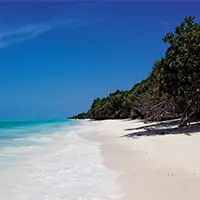
Nungwi beach
This is why you booked a Zanzibar excursion, the beaches. And the beach you need to visit is the Nungwi Beach. The Nungwi village is found on Zanzibar’s North West tip. This is a popular place, yet it’s not congested with tourists. It is one of Zanzibar’s top beaches since the tide doesn’t retreat too far. This is a great beach for those looking to just soak up some sun and dip their toes in the sea.
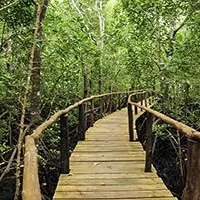
Jozani Forest
Jozani is the last indigenous forest left on Zanzibar. It is a vast and lush blanket of green, It is located inland from Chwaka Bay. The area often floods, which luckily nurtures a unique swamp forest of many amazing looking trees and ferns. The forest is best reached via bus, chartered taxi, or as part of a tour.
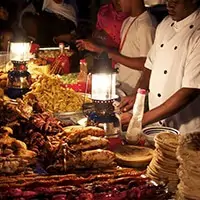
Forodhani Market
A spectacular night-time food market, Forodhani opens in the late afternoon in Stone Town. This market is alive with energy. Here you will find fresh local produce as well as freshly grilled fish, meat and vegetables. The seafood options are by far the most popular and the fish is served with fried potato balls, naan and samosas.
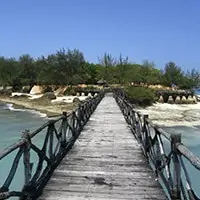
Prison Island
Prison Island provides tourists a glimpse into the island’s dark history. It is located about a half-hour boat ride from Zanzibar. This land was once used as a place where slaves were detained. Once slavery was abolished, it functioned as a quarantine camp for people with deadly diseases. Today the island is a nature reserve for giant tortoises and a place to see the ruins that once functioned as the prison.
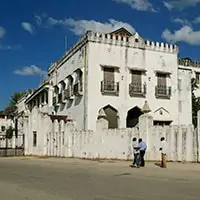 Palace Museum
Palace Museum
Commonly know as the Sultan’s Palace, The Palace Museum is perhaps the most historic building in Stone Town and is a must-see for any tourist. The Palace Museum is located along the waterfront, overlooking the ocean. It was built in the 19th century as a home for the Sultan and his family. After the 1964 revolution, the palace was used as a Government building and was renamed as The People’s Palace. Today it serves as a museum of the past Sultan families.
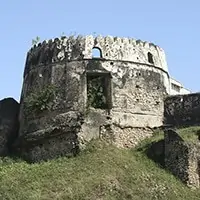
The Old Fort
The oldest building in Stone Town, the Old Fort is also located along the waterfront. It is in front of the famous Forodhani Gardens. It was originally built in the 17th century with the purpose of defending the island from attacks from the Portuguese. Today it is a mainly an attraction for tourists. Visitors can admire the remains of the fort and stroll around the center courtyard. Sellers have local produce and souvenirs for sale. An old amphitheater still hosts events and functions in the fort.
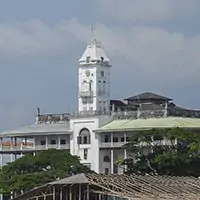
House of Wonders
The House of Wonders show the cultural and architectural influences of Zanzibar, Britain, Portugal, and Oman over the centuries. When it was built it was the most modern building in East Africa. It was the first building to have electricity and an elevator. The House of Wonders hosts a historical exhibition and offers insight into Zanzibari and Swahili culture. It is a very important and visually stunning historic building in Stone Town. The House of Wonders is the grandest and tallest building in all of Stone Town and is found in a prominent location in front of the Forodhani Gardens on the old town’s waterfront along Mizingani Road.
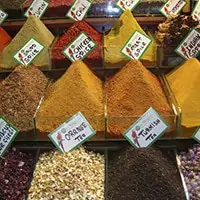
Spice Tour
As we mentioned earlier, Zanzibar is known for its spice trade, so what better way to immerse yourself in the local culture than learning about its wealthiest and most profitable industry? Tourists can choose from a variety of tours and explore the winding streets with expert tour guides who will guide you through the origins of the industry, as well as teaching guests about the wide variety of spices that Zanzibar produces and trades.
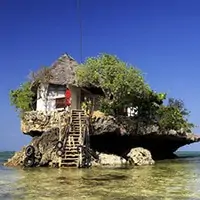
The Rock
Visitors are treated with not only a stunning view but fine dining as well. The restaurant is located on a rock with a view over all the city’s main sights. The Rock has some of the best seafood Zanzibar has to offer. Make sure to make reservations since this exclusive restaurant has only 12 tables and it’s often fully booked.





